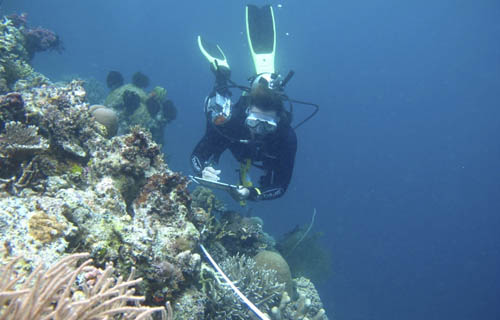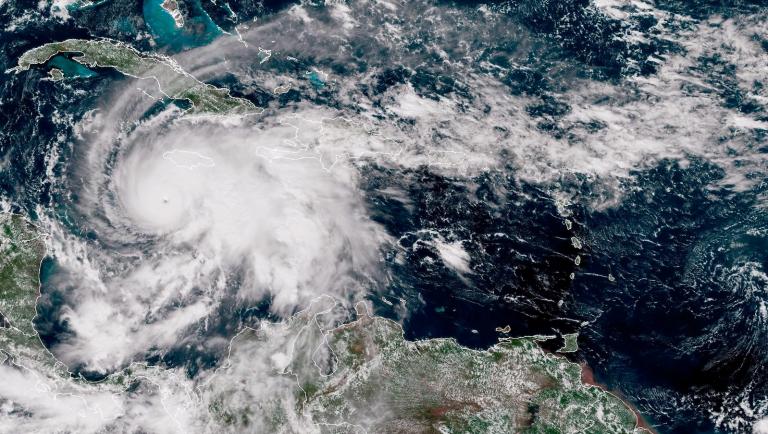 Joanne Wilson surveying coral reefs in Raja Ampat Cross-posted from Cool Green Science.
Joanne Wilson surveying coral reefs in Raja Ampat Cross-posted from Cool Green Science.
You’ve probably heard about coral bleaching — the mass die-off of coral reefs because of warming sea temperatures, a dynamic that can be attributed at least indirectly to climate change. It’s a problem of growing concern to the hundreds of millions of people whose lives depend on reefs and the fish they shelter. But as ocean temps continue to rise, is there any hope for coral?
Science to the rescue! Researchers are learning tons about which kinds of coral species are either resistant to bleaching or bleach more quickly — and using that data to figure out which reefs are going to be more resilient to climate change … which will feed into where to focus protection efforts. As part of the work, marine scientists often need to do painstaking fish and coral surveys in beautiful but remote locations — which is why The Nature Conservancy sent a science team led by Joanne Wilson and Sangeeta Mangubhai to spend two weeks in November in the Indonesian archipelago of Raja Ampat, known as the global center of marine biodiversity. I caught up with Wilson and Mangubhai — barely dry from all their diving — to get the skinny on what they found, including giant clams and an anchovy fish ball.
Q. You found less coral bleaching on this expedition than you’d thought you would. How significant is that finding? Should we be less worried about coral bleaching than we were before?
Joanne Wilson: Coral bleaching occurs when water temperatures are warmer than normal — for example, during La Niña events like the one we experienced last year. The increasing frequency and intensity of these warming events is associated with climate change. Fortunately, during our expedition, water temperatures were within normal ranges, so corals on Misool reefs were not bleaching. But with bleaching events predicted to increase in the future, we are still vigilant and concerned about Raja Ampat’s reefs.
Q. OK, so we’re still concerned about bleaching — but what can we really do about it?
JW: We can help build reef resilience. During the surveys we did find a few pale corals, indicating slight temperature stress. These corals belonged to a species that is very sensitive to temperature stress. Studying those corals will help us better understand the different responses of coral species to increased water temperatures. By combining this new knowledge with information on the distribution of coral species, we can predict with increased accuracy which reefs are likely to be more vulnerable to bleaching in the future — which can in turn can guide reef resilience efforts.
Q. Marine protected areas like the one you were visiting often have “no-take” zones where fishing is restricted or banned. You were studying whether fish were bigger and more numerous in these zones — essentially, whether these zones were serving as “fish banks” for the rest of the region. Are they?
Sangeeta Mangubhai: Our expedition took us to the Southeast Misool MPA [marine protected area], which is still in the process of being zoned, though there is currently one 425-square-kilometer [164-square-mile] no-take zone that is being actively enforced. Our data show that the fish biomass and abundance were higher within the existing no-take zone, especially in areas with high current (often at the points of islands) where many fish species tend to aggregate. We also recorded more sharks in the no-take zone as compared to other areas of the MPA where fishing continues. So yes, the existing no-take zone is acting as a fish bank. However, given how overfished the reefs are in Misool, it will take a few more years before the no-take zone accumulates enough fish to spill over into adjacent areas.
Q. How do you determine whether fish are bigger and more abundant in a particular region? How do you know you’re not just finding a lot of big fish that day?
SM: Over the last two years, we’ve been classifying the reefs in Misool to give us a better understanding of the range of coral reef habitats there. We do this because we know all coral reefs are not the same — they differ depending on the habitat and oceanographic conditions they are exposed to, and so do their fish populations. The fish population in a lagoonal reef is going to be different — both in terms of species and numbers — from the fish population in an adjacent reef that’s exposed to waves and wind.
When we do our reef health surveys, we make sure that we are surveying similar reef habitats so that the data is comparable. We also survey multiple reefs belonging to the same habitat type, so that we can develop an average that reflects the general condition of the reefs. In addition, we know which fish tend to spread themselves out on a reef, and which tend to aggregate in large schools, and we take this into account when we do our surveys and when we interpret the data.
Q. Speaking of aggregation, you also found a “fish ball” of anchovies — which I’m guessing isn’t something that goes into a Caesar salad. What is it? Why is it significant?
JW: An anchovy fish ball is an aggregation of perhaps millions of these small silver fish. By following the principle of safety in numbers, these anchovies were hoping that at least some of them would escape being eaten. Anchovies form the base of the food chain — they’re a staple meal for fish like tuna, for sea birds and for many whale and dolphin species. They are also caught by the ton and then dried and sold for human consumption in Indonesia. So it’s important that anchovy habitat is protected and the anchovy fishery is well managed to provide for both a healthy ecosystem and a sustainable harvest.
 A veritable Dr. Seuss book of coral. From left to right, cynarina, physogyra, euphyllia ancora and lobophyllia coral.Q. One scientist I know described the fish and corals in the Coral Triangle (CT) like something out of a Dr. Seuss book — totally wild. You both have done a lot of diving in the CT — did you see anything this time you’d never seen before?
A veritable Dr. Seuss book of coral. From left to right, cynarina, physogyra, euphyllia ancora and lobophyllia coral.Q. One scientist I know described the fish and corals in the Coral Triangle (CT) like something out of a Dr. Seuss book — totally wild. You both have done a lot of diving in the CT — did you see anything this time you’d never seen before?
JW: Absolutely. This is the center of reef biodiversity, so we certainly saw a lot of creatures that are not commonly found in other reefs and had us poring over photos and reaching for the reference books each evening! Some of the coral species form weird and wonderful fragile shapes in very sheltered coves among the limestone karst. We found a strangely shaped anemone that looked a lot like a black fern and also came across mating octopuses on two occasions.
Q. A number of Indonesian scientists helped you do the monitoring on this expedition. Does that presence help the credibility of your findings with the people who live in Raja Ampat? And how are your findings going to be used there?
SM: There are a number of reasons we have mainly Indonesian scientists on our trips. First, the Conservancy feels that if we work in a country like Indonesia, it is important to invest in long-term capacity and empower local scientists to lead the monitoring work themselves instead of relying on outsiders. Second, it does create real credibility for our findings at the local level as well as a great sense of pride for communities to have locals involved in an expedition and collecting data on their reefs. And third, it is the Indonesian scientists that will be working with outreach staff and the local communities to finalize a zoning plan for the MPA — to do this, they need to be experts with firsthand knowledge and understanding of the reefs, to enable them to stand on equal footing with local communities while discussing the communities’ resources and how best to manage them. Local scientists know how to speak to their government and communities better than outsiders.
Q. Everybody thinks diving is fun and glamorous, but Raja Ampat isn’t an easy place to work — you had to bring in everything you needed from a town 98 miles away across open ocean, which I understand is 16 hours by steamboat. What was the most challenging thing about this expedition?
SM: Given how remote this region is, we had to put a lot of thought and planning into the trip before it began. There was no shop we could duck into to pick up something we had forgotten, so we needed spares of essential equipment. We had to be prepared to fix any equipment that malfunctioned or broke down ourselves. Every night, on top of entering our data, we also had to take inventory — check how much fuel we had used, investigate the state of our gear, and decide where we could safely anchor the boat each night, taking into account that there were many unmarked reefs we couldn’t afford to damage. In some areas, we had to rely on the local knowledge of our community monitoring assistants to safely navigate narrow passages. With no accurate information available on tides and currents, we had to make sure that, when we chose dive sites, the currents were not too strong. And we had to be prepared to put into place additional safety measures, if they were required for the dive.
Q. Coral reefs are in trouble worldwide — most everybody knows that. But are you as scientists more hopeful now than you were before the expedition about our ability to protect them? Why or why not?
JW: We came away from the expedition with mixed feelings. Raja Ampat is certainly a very beautiful and diverse area, but even this far-flung corner of Indonesia, the reefs showed signs of overexploitation and damage from bomb fishing.
But we saw strong positive signs, too — all of the local community members on our expedition used to be illegal fishermen, and now they’re now active conservationists. There’s now an agreement between Misool Eco Resort — a local dive resort — and local villages to sustainably manage local reefs while creating livelihood opportunities. We’re also supporting the local government’s efforts to develop management plans for all of Raja Ampat’s marine protected areas. This will give some communities their first opportunity to affect the decisions that determine how their resources are used and accessed. So while there’s still reef exploitation, these developments give us hope.



